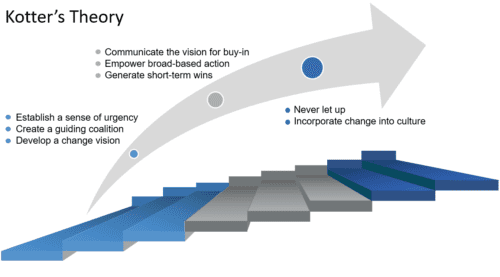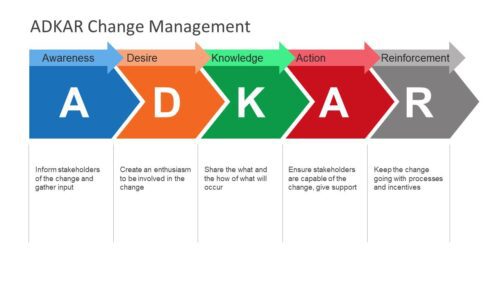Change is inevitable. You’ve heard the saying time and time again. Yet, change can also be intentional. Organizations around the world are constantly changing – innovating or improving. They spend time, money, and resources to determine the best ways to change, as well as how they are going to do so. Yet, when the time comes to do it, how do you assure that all of your changes stick successfully? 3 words: Organizational Change Models.
The Simple Answer: Organizational Change Models
Now that you’ve invested a lot into your projects, you are ready to recognize the return on investment as quickly and as fully as possible. We get it. Throughout our process improvement engagement, we planned for organizational change management. Our approach is anchored in Kotter’s Theory and ADKAR, resulting in added value and success from the individual to the macro level.
Organizational Management Planning
At the high level, these approaches offer you a checklist for your organizational change management planning. This gives you a tangible place to start in enabling your organization towards lasting change.
Your plan should include:
- Create and share a vision
- Create momentum for change
- Develop, grow, and sustain the momentum
- Maintain the results of the change
Model #1: Kotter’s Theory
Kotter’s Theory is an 8-step process that was developed through Dr. Kotter’s observations of 100 organizations engaged in a process of change. This step-by-step approach assures that there is buy-in from your team, organization, subject matter experts, and stakeholders.

So what are the 8 steps?
- Create a sense of urgency – evaluate and share the benefits, as well as the need for change with your organization
- Build a guiding coalition – utilize trusted, enthusiastic, individuals of your organization to champion the change
- Form a strategic vision and initiatives – developing a vision through a collaborative effort will ensure direction while promoting buy-in
- Enlist a volunteer army – massive, impactful change takes an army working together, pulling hard to get the ship moving.
- Enable action by removing barriers – remove restrictions on creativity or process that are slow or inefficient.
- Generate short-term wins – identify opportunities for immediate improvement that can help create momentum for change. This will encourage movement and future buy-in.
- Sustain accelerations – regular check-ins, evaluations, and adjustments are a must. Movement is hard to continue once it has stopped, so keep the momentum going!
- Institute change – demonstrate how the urgency and buy-in accomplished the goals of change. Consider things like how the organization improved and how are you positioned to succeed in the future.
Strengths
Kotter’s Theory is intuitive to follow, backed by observational research, and it is a clear guide to utilizing strengths within your organization to assure ensure is successful.
Weaknesses
Although change takes time, the step-by-step nature of this process may extend that time. Extensive planning must be done to ensure these steps are done in sequential order, as well as to ensure success. This limits the agility of the model and the ability to adjust quickly at any stage of the process.
Model #2: ADKAR

The founder of a global leader in change management, Prosci, created the ADKAR organizational model. In this model, Jeff Hiatt outlines 5 outcomes needed to ensure that your changes last and are successful. The overall theme of the ADKAR model is that true change occurs when the individuals of your organization change.
The 5 Outcomes of the ADKAR Model:
- Awareness of the need for change – Inform your employees and stakeholders of the change and action, and ask for input
- Desire to support the change – You must develop the desire to support, as a failure in individual support will impact further efforts
- Knowledge of how to change – This is about knowing the what, as well as the how. Inform employees and stakeholders on the how and ask for their input. Out of this, create an action plan and enable execution.
- Ability to demonstrate skills & behaviors – Gauge your employees’ ability to execute the proper actions of the change, identify any gaps, and provide support where needed.
- Reinforcement to make the change stick – Ensure that the change is stable on the individual level through setting defined processes and incentives to keep the change moving.
Strengths
This model is agile, flexible, and outcome-oriented. Along with this, it allows for adjustments in-process and focuses on success at the individual level. This focus creates improved chances for success. Also, this method clearly states desired outcomes and shifts actions towards those outcomes.
Weaknesses
If you have large change management needs, ADKAR may not be the best fit for your organization, as it is so focused on that individual level. Also, the inputs are less defined, which means this model should only be used if the desired change is known and well defined.
Adapt These Models For Your Organization
Agile + Smaller Change? Start Here
If you are working on smaller change initiatives, the flexibility of the ADKAR model may fit your needs the best. This approach is outcome-oriented, as well as thrives on individual adoption to ultimately foster change.
However, this approach may lack the structure that is needed for a larger organization or initiative.
Complex + Large Initiative? Start Here
If your organization is embarking on a larger, more complicated effort, Kotter’s Theory is for you! This step-by-step approach provides a clear path to ensuring success in your long-term efforts towards change, as long as appropriate resources are available.
Somewhere in the Middle? Start Here
Of course, there is always a middle ground! A hybrid approach of ADKAR and Kotter’s Theory is often the route we choose here at TSI.
Highlights of this approach are as follows:
- Begin by understanding your organization’s Readiness for Change
- Start a movement through building a vision and involving stakeholders
- Grow this movement through empowerment and communication
- Sustain this movement through enablement and removing current barriers
- Maintain movement results with reinforcement and short-term success as the change becomes institutionalized
What You Can Expect From Us
Although this was a lot of information, this does not even begin to demonstrate all of the organizational change models out there. However, these are two that we believe in and have seen proven in creating lasting change. This is especially true when key portions of each method work together with our proven methodology.
- We begin with an organizational context discussion, setting the basis for the design of your ideal future state.
- Next, we analyze current state processes, identifying any gaps in ability or knowledge.
- From there, we work with you to develop and implement a plan to fill those gaps.
- Finally, determine the best way to sustain, institute, and reinforce change.
BONUS: We also involve those responsible for the workflows in the design process to encourage buy-in.
Whether you are feeling ready to dive in or overwhelmed with where to start, reach out to us to set up an initial call. We would love to walk through these processes in more detail, as well as help you determine which approach may be best for your organization.
